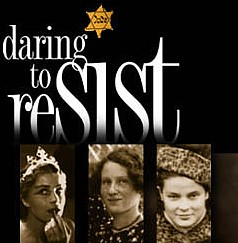Bibliography (back
to top)
- Aubrac, Lucie. Outwitting the Gestapo. Lincoln: University
of Nebraska Press, 1993.
Outwitting the Gestapo, based on the true story of Lucie Aubrac
who worked for the French Resistance during World War II, retells Aubrac’s
wartime activities through the form of a diary. Particularly interesting
within this book is the way in which the author explains how her own
gender helped to aid her in her resistance efforts. By using traditional
gender roles, Aubrac was able to further her abilities to work against
the Nazis. (Amber McDonald)
- Baumel, Judith Tydor. Double Jeopardy: Gender and the Holocaust.
London: Vallentine Mitchell, 1998.
Double Jeopardy explores the role that gender stereotypes played
in the Holocaust. The author looks into how one’s gender affected social
interaction, leadership and heroism. Focusing on the experiences of
Jewish women, Baumel stresses the importance gender played in women’s
reactions to the Holocaust. (Amber McDonald)
- Eman, Diet. Things We Couldn’t Say. Grand Rapid, Michigan:
Wm. B. Eerdmans Publishing Co., 1994.
Taken from both journal entries and reflections of the author, Things
We Couldn’t Say tells the story of a woman involved in resistance
work in Holland during Nazi occupation. The author particularly emphasizes
the role that both her religion and her gender aided her in continuing
her resistance efforts during the course of the war. (Amber McDonald)
- Gurewitsch, Brana. Mothers, Sisters, Resisters: Oral Histories
of Women who Survived the Holocaust. Tuscaloosa: University of Alabama
Press, 1998.
In Mothers, Sisters, Resisters, Brana Gurewitsch gathers together
powerful accounts and personal testimonies of women’s experiences during
the Holocaust. Their stories preserve the special relationships formed
between women and their struggle to resist and survive Nazi Germany.
(Roselie Smith)
- Harvey, Elizabeth. Women and the Nazi East: Agents and Witnesses
of Germanization. New Haven: Yale University Press, 2003.
Women in the Nazi East helps to explain what roles were expected
of women and how they attempted to propagate these roles within conquered
territories such as Poland and Czechoslovakia. This book also details
how women were expected to fill these roles- the "transplanting"
of native German women to conquered territories in an effort to "Germanize"
the new acquisitions of the Third Reich. (Amber McDonald)
- Ofer, Dalia and Lenore J. Weitzman. Women in the Holocaust.
New Haven: Yale University Press, 1998.
Women in the Holocaust is a collection of personal stories of
mostly female survivors of the Holocaust. The women who tell their stories
include details about what classifications qualified someone as Jewish.
The sections about resistance include tips for survival and explanations
of how they survived. (Vanessa Boomgaard)
- Owings, Alison. Frauen: German Women Recall the Third Reich.
New Jersey: Rutgers University Press, 1993.
Frauen: German Women Recall the Third Reich is a collection of
stories about women who lived in Germany during World War II. The stories
vary among German Jews, German (non-Jewish) children, German resistors
and German women who survived the concentration camps. (Nicole Bronstein)
- Stibbe, Matthew. Women in the Third Reich. New York: Oxford
University Press, 2003.
Women in the Third Reich is a synthesis of critical work written
by recent historians focusing on the role of women under the shadows
of the Third Reich. Stibbe argues that factors such as class, race,
religion and marital status played a more significant part in women’s
lives than gender. Chapter Six specifically focuses on women who did
not support the Nazi Regime. It explains the type of opposition: how
resistance was organized, opposition and non-conformity in everyday
life, and how Germans helped those Jews within concentration camps.
(Roselie Smith and Vanessa Boomgaard)
|
